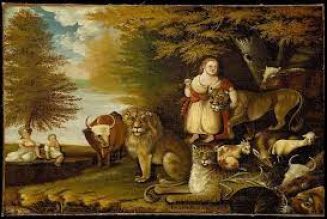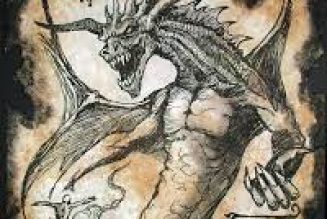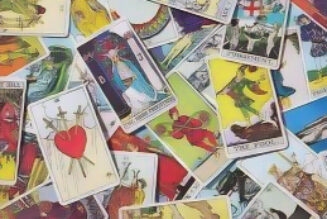Dionysos’ sacred animals were the panther (leopard), tiger, bull and serpent. The god rode on the back of a panther or drove a chariot drawn by a pair of the beasts.
His sacred plants were the grapevine, ivy, bindweed (prickly ivy) and pine tree. Devotees of the god wore wreaths of ivy and carried pine-cone tipped staffs.
Below are examples of the god’s animals as depicted in ancient Greek art and photos of his sacred plants:-
1. Panther;
2. Grapevine;
3. Ivy;
4. Bindweed;
5. Pine tree.
SYMBOLS & ATTRIBUTES
Dionysos’ most distinctive attribute was the thyrsos, a pine-cone tipped staff. His other attributes included a drinking-cup (kantharos), fruiting grapevines and a panther.
The god was usually clothed in a long robe (chiton) and cloak (himation) and crowned with a wreath of ivy-leaves.
Below are some examples of his attributes as depicted in ancient Greek art:-
1. Pine-cone staff (thyrsos);
2. Thyrsos-staff head
3. Grapevines;
4. Drinking-cup;
5. Wreath of ivy-leaves.
THE BIRTH OF DIONYSUS
Pseudo-Apollodorus, Bibliotheca 3. 26 – 28 (trans. Aldrich) (Greek mythographer C2nd A.D.) :
“Zeus fell in love with Semele and slept with her, promising her anything she wanted, and keeping it all from Hera. But Semele was deceived by Hera into asking Zeus to come to her as he came to Hera during their courtship. So Zeus, unable to refuse, arrived in her bridal chamber in a chariot with lightning flashes and thunder, and sent a thunderbolt at her. Semele died of fright, and Zeus grabbed from the fire her six-month aborted baby, which he sewed into his thigh. After Semele’s death the remaining daughters of Kadmos (Cadmus) circulated the story that she had slept with a mortal, thereafter accusing Zeus, and because of this had been killed by a thunderbolt. At the proper time Zeus loosened the stitches and gave birth to Dionysos, whom he entrusted to Hermes.”
For MYTHS of the birth of Dionysos see:
(1) Birth & Death of Dionysus-ZAGREUS (Orphic myth)
(2) Birth & Nursing of Dionysus
II. NURSED BY INO & THE NYSIADES
Pseudo-Apollodorus, Bibliotheca 3. 29 – 30 :
“Zeus loosened the stitches and gave birth to Dionysos, whom he entrusted to Hermes. Hermes took him to Ino and Athamas, and persuaded them to bring him up as a girl. Incensed, Hera inflicted madness on them. As for Zeus, he escaped Hera’s anger by changing Dionysos into a baby goat. Hermes took him to the Nymphai of Asian Nysa, whom Zeus in later times places among the stars and named the Hyades.”
DIONYSOS, the youthful, beautiful, but effeminate god of wine. He is also called both by Greeks and Romans Bacchus (Bakchos), that is, the noisy or riotous god, which was originally a mere epithet or surname of Dionysus, but does not occur till after the time of Herodotus.
According to the common tradition, Dionysus was the son of Zeus and Semele, the daughter of Cadmus of Thebes (Hom. Hymn. vi. 56; Eurip. Bacch. init.; Apollod. iii. 4. § 3); whereas others describe him as a son of Zeus by Demeter, Io, Dione, or Arge. (Diod. iii. 62, 74; Schol. ad Pind. Pyth. iii. 177; Plut. de Flum. 16.) Diodorus (iii. 67) further mentions a tradition, according to which he was a son of Ammon and Amaltheia, and that Ammon, from fear of Rhea, carried the child to a cave in the neighbourhood of mount Nysa, in a lonely island formed by the river Triton. Ammon there entrusted the child to Nysa, the daughter of Aristaeus, and Athena likewise undertook to protect the boy. Others again represent him as a son of Zeus by Persephone or Iris, or describe him simply as a son of Lethe, or of Indus. (Diod. iv. 4; Plut. Sympos. vii. 5; Philostr. Vit. Apollon. ii. 9.)
The same diversity of opinions prevails in regard to the native place of the god, which in the common tradition is Thebes, while in others we find India, Libya, Crete, Dracanum in Samos, Naxos, Elis, Eleutherae, or Teos, mentioned as his birthplace. (Hom. Hymn. xxv. 8; Diod. iii. 65, v. 75; Nonnus, Dionys. ix. 6; Theocrit. xxvi. 33.) It is owing to this diversity in the traditions that ancient writers were driven to the supposition that there were originally several divinities which were afterwards identified under the one name of Dionysus. Cicero (de Nat. Deor. iii 23) distinguishes five Dionysi, and Diodorus (iii. 63, &c.) three.
The common story, which makes Dionysus a son of Semele by Zeus, runs as follows: Hera, jealous of Semele, visited her in the disguise of a friend, or an old woman, and persuaded her to request Zeus to appear to her in the same glory and majesty in which he was accustomed to approach his own wife Hera. When all entreaties to desist from this request were fruitless, Zeus at length complied and appeared to her in thunder and lightning. Semele was terrified and overpowered by the sight, and being seized by the fire, she gave premature birth to a child. Zeus, or according to others, Hermes (Apollon. Rhod. iv. 1137) saved the child from the flames: it was sewed up in the thigh of Zeus, and thus came to maturity. Various epithets which are given to the god refer to that occurrence, such as purigenês, mêrorraphês, mêrotraphês and ianigena. (Strab. xiii. p. 628; Diod. iv. 5; Eurip. Bacch. 295; Eustath. ad Hom. p. 310; Ov. Met. iv. 11.)
After the birth of Dionysus, Zeus entrusted him to Hermes, or, according to others, to Persephone or Rhea (Orph. Hymn. xlv. 6; Steph. Byz. s. v. Mastaura), who took the child to Ino and Athamas at Orchomenos, and persuaded them to bring him up as a girl. Hera was now urged on by her jealousy to throw Ino and Athamas into a state of madness, and Zeus, in order to save his child, changed him into a ram, and carried him to the nymphs of mount Nysa, who brought him up in a cave, and were afterwards rewarded for it by Zeus, by being placed as Hyades among the stars. (Hygin. Fab. 182; Theon, ad Arat. Phaen. 177; comp. Hyades.)
The inhabitants of Brasiae, in Laconia, according to Pausanias (iii. 24. § 3), told a different story about the birth of Dionysus, When Cadmus heard, they said, that Semele was mother of a son by Zeus, he put her and her child into a chest, and threw it into the sea. The chest was carried by the wind and waves to the coast of Brasiae. Semele was found dead, and was solemnly buried, but Dionysus was brought up by Ino, who happened at the time to be at Brasiae. The plain of Brasiae was, for this reason, afterwards called the garden of Dionysus.
The traditions about the education of Dionysus, as well as about the personages who undertook it, differ as much as those about his parentage and birthplace. Besides the nymphs of mount Nysa in Thrace, the muses, Lydae, Bassarae, Macetae, Mimallones (Eustath. ad Hom. pp. 982, 1816), the nymph Nysa (Diod. iii. 69), and the nymphs Philia, Coronis, and Cleis, in Naxos, whither the child Dionysus was said to have been carried by Zeus (Diod. iv. 52), are named as the beings to whom the care of his infancy was entrusted. Mystis, moreover, is said to have instructed him in the mysteries (Nonn. Dionys. xiii. 140), and Hippa, on mount Tmolus, nursed him (Orph. Hymn. xlvii. 4); Macris, the daughter of Aristaeus, received him from the hands of Hermes, and fed him with honey. (Apollon. Rhod. iv. 1131.) On mount Nysa, Bromie and Bacche too are called his nurses. (Serv. ad Virg. Eclog. vi. 15.)
Mount Nysa, from which the god was believed to have derived his name, was not only in Thrace and Libya, but mountains of the same name are found in different parts of the ancient world where he was worshipped, and where he was believed to have introduced the cultivation of the vine. Hermes, however, is mixed up with most of the stories about the infancy of Dionysus, and he was often represented in works of art, in connexion with the infant god. (Comp. Paus. iii. 18. § 7.)
When Dionysus had grown up, Hera threw him also into a state of madness, in which he wandered about through many countries of the earth. A tradition in Hyginus (Poet. Astr. ii. 23) makes him go first to the oracle of Dodona, but on his way thither he came to a lake, which prevented his proceeding any further. One of two asses he met there carried him across the water, and the grateful god placed both animals among the stars, and asses henceforth remained sacred to Dionysus.
According to the common tradition, Dionysus first wandered through Egypt, where he was hospitably received by king Proteus. He thence proceeded through Syria, where he flayed Damascus alive, for opposing the introduction of the vine, which Dionysus was believed to have discovered (euretês ampelou). He now traversed all Asia. (Strab. xv. p. 687; Eurip. Bacch. 13.) When he arrived at the Euphrates, he built a bridge to cross the river, but a tiger sent to him by Zeus carried him across the river Tigris. (Paus. x. 29; Plut. de Flum. 24.)
The most famous part of his wanderings in Asia is his expedition to India, which is said to have lasted three, or, according to some, even 52 years. (Diod. iii. 63, iv. 3.) He did not in those distant regions meet with a kindly reception everywhere, for Myrrhanus and Deriades, with his three chiefs Blemys, Orontes, and Oruandes, fought against him. (Steph. Byz. s.v. Blemues, Gazos, Gêreia, Dardai, Eares, Zabioi, Malloi, Pandai, Sibai.) But Dionysus and the host of Pans, Satyrs, and Bacchic women, by whom he was accompanied, conquered his enemies, taught the Indians the cultivation of the vine and of various fruits, and the worship of the gods; he also founded towns among them, gave them laws, and left behind him pillars and monuments in the happy land which he had thus conquered and civilized, and the inhabitants worshipped him as a god. (Comp. Strab. xi. p. 505; Arrian, Ind. 5; Diod. ii. 38; Philostr. Vit. Apollon. ii. 9; Virg. Aen. vi. 805.)
Dionysus also visited Phrygia and the goddess Cybele or Rhea, who purified him and taught him the mysteries, which according to Apollodorus (iii. 5. § 1.) took place before he went to India. With the assistance of his companions, he drove the Amazons from Ephesus to Samos, and there killed a great number of them on a spot which was, from that occurrence, called Panaema. (Plut. Quaest. Gr. 56.) According to another legend, he united with the Amazons to fight against Cronus and the Titans, who had expelled Ammon from his dominions. (Diod. iii. 70, &c.) He is even said to have gone to Iberia, which, on leaving, he entrusted to the government of Pan. (Plut. de Flum. 16.)
On his passage through Thrace he was ill received by Lycurgus, king of the Edones, and leaped into the sea to seek refuge with Thetis, whom he afterwards rewarded for her kind reception with a golden urn, a present of Hephaestus. (Hom. Il. vi. 135, &c., Od. xxiv. 74; Schol. ad Hom. Il. xiii. 91. Comp. Diod. iii. 65.) All the host of Bacchantic women and Satyrs, who had accompanied him, were taken prisoners by Lycurgus, but the women were soon set free again. The country of the Edones thereupon ceased to bear fruit, and Lycurgus became mad and killed his own son, whom he mistook for a vine, or, according to others (Serv. ad Aen. iii. 14) he cut off his own legs in the belief that he was cutting down some vines. When this was done, his madness ceased, but the country still remained barren, and Dionysus declared that it would remain so till Lycurgus died. The Edones, in despair, took their king and put him in chains, and Dionysus had him torn to pieces by horses.
After then proceeding through Thrace without meeting with any further resistance, he returned to Thebes, where he compelled the women to quit their houses, and to celebrate Bacchic festivals on mount Cithaeron, or Parnassus. Pentheus, who then ruled at Thebes, endeavoured to check the riotous proceedings, and went out to the mountains to seek the Bacchic women; but his own mother, Agave, in her Bacchic fury, mistook him for an animal, and tore him to pieces. (Theocrit. Id. xxvi.; Eurip. Bacch. 1142; Ov. Met. iii. 714, &c.)
After Dionysus had thus proved to the Thebans that he was a god, he went to Argos. As the people there also refused to acknowledge him, he made the women mad to such a degree, that they killed their own babes and devoured their flesh. (Apollod. iii. 5. § 2.) According to another statement, Dionysus with a host of women came from the islands of the Aegean to Argos, but was conquered by Perseus, who slew many of the women. (Paus. ii. 20. § 3, 22. § 1.) Afterwards, however, Dionysus and Perseus became reconciled, and the Argives adopted the worship of the god, and built temples to him. One of these was called the temple of Dionysus Cresius, because the god was believed to have buried on that spot Ariadne, his beloved, who was a Cretan. (Paus. ii. 23. § 7.)
The last feat of Dionysus was performed on a voyage from Icaria to Naxos. He hired a ship which belonged to Tyrrhenian pirates; but the men, instead of landing at Naxos, passed by and steered towards Asia to sell him there. The god, however, on perceiving this, changed the mast and oars into serpents, and himself into a lion; he filled the vessel with ivy and the sound of flutes, so that the sailors, who were seized with madness, leaped into the sea, where they were metamorphosed into dolphins. (Apollod. iii. 5. § 3; Hom. Hymn. vi. 44; Ov. Met. iii. 582, &c.) In all his wanderings and travels the god had rewarded those who had received him kindly and adopted his worship : he gave them vines and wine.
After he had thus gradually established his divine nature throughout the world, he led his mother out of Hades, called her Thyone, and rose with her into Olympus. (Apollod. l. c.) The place, where he had come forth with Semele from Hades, was shown by the Troezenians in the temple of Artemis Soteira (Paus. ii. 31. § 2); the Argives, on the other hand, said, that he had emerged with his mother from the Alcyonian lake. (Paus. ii. 37. § 5; Clem. Alex. Adm. ad Gr. p. 22.) There is also a mystical story, that the body of Dionysus was cut up and thrown into a cauldron by the Titans, and that he was restored and cured by Rhea or Demeter. (Paus. viii. 37. § 3; Diod. iii. 62; Phurnut. N. D. 28.)
Various mythological beings are described as the offspring of Dionysus; but among the women, both mortal and immortal, who won his love, none is more famous in ancient history than Ariadne. The extraordinary mixture of traditions which we have here had occasion to notice, and which might still be considerably increased, seems evidently to be made up out of the traditions of different times and countries, referring to analogous divinities, and transferred to the Greek Dionysus.
We may, however, remark at once, that all traditions which have reference to a mystic worship of Dionysus, are of a comparatively late origin, that is, they belong to the period subsequent to that in which the Homeric poems were composed; for in those poems Dionysus does not appear as one of the great divinities, and the story of his birth by Zeus and the Bacchic orgies are not alluded to in any way : Dionysus is there simply described as the god who teaches man the preparation of wine, whence he is called the “drunken god ” (mainomenos), and the sober king Lycurgus will not, for this reason, tolerate him in his kingdom. (Hom. Il. vi. 132, &c., Od. xviii. 406, comp. xi. 325.) As the cultivation of the vine spread in Greece, the worship of Dionysus likewise spread further; the mystic worship was developed by the Orphici, though it probably originated in the transfer of Phrygian and Lydian modes of worship to that of Dionysus. After the time of Alexander’s expedition to India, the celebration of the Bacchic festivals assumed more and more their wild and dissolute character.
As far as the nature and origin of the god Dionysus is concerned, he appears in all traditions as the representative of some power of nature, whereas Apollo is mainly an ethical deity. Dionysus is the productive, overflowing and intoxicating power of nature, which carries man away from his usual quiet and sober mode of living. Wine is the most natural and appropriate symbol of that power, and it is therefore called “the fruit of Dionysus.” (Dionusou karpos; Pind. Fragm. 89, ed. Böckh.) Dionysus is, therefore, the god of wine, the inventor and teacher of its cultivation, the giver of joy, and the disperser of grief and sorrow. (Bacchyl. ap. Athen. ii. p. 40; Pind. Fragm. 5; Eurip. Bacch. 772.)
As the god of wine, he is also both an inspired and an inspiring god, that is, a god who has the power of revealing the future to man by oracles. Thus, it is said, that he had as great a share in the Delphic oracle as Apollo (Eurip. Bacch. 300), and he himself had an oracle in Thrace. (Paus. ix. 30. § 5.) Now, as prophetic power is always combined with the healing art, Dionysus is, like Apollo, called iatpos, or hugiatês (Eustath. ad Hom. p. 1624), and at his oracle of Amphicleia, in Phocis, he cured diseases by revealing the remedies to the sufferers in their dreams. (Paus. x. 33. § 5.) Hence he is invoked as a theos sôtêr against raging diseases. (Soph. Oed. Tyr. 210; Lycoph. 206.)
The notion of his being the cultivator and protector of the vine was easily extended to that of his being the protector of trees in general, which is alluded to in various epithets and surnames given him by the poets of antiquity (Paus. i. 31. § 2, vii. 21. § 2), and he thus comes into close connexion with Demeter. (Paus. vii. 20. § 1; Pind. Isthm. vii. 3; Theocrit. xx. 33; Diod. iii. 64; Ov. Fast. iii. 736; Plut. Quaest. Gr. 36.)
This character is still further developed in the notion of his being the promoter of civilization, a law-giver, and a lover of peace. (Eurip. Bacch. 420; Strab. x. p. 468; Diod. iv. 4.) As the Greek drama had grown out of the dithyrambic choruses at the festivals of Dionysus, he was also regarded as the god of tragic art, and as the protector of theatres. In later times, he was worshipped also as a theos chthonios, which may have arisen from his resemblance to Demeter, or have been the result of an amalgamation of Phrygian and Lydian forms of worship with those of the ancient Greeks. (Paus. viii. 37, § 3; Arnob. adv. Gent. v. 19.)
The orgiastic worship of Dionysus seems to have been first established in Thrace, and to have thence spread southward to mounts Helicon and Parnassus, to Thebes, Naxos, and throughout Greece, Sicily, and Italy, though some writers derived it from Egypt. (Paus. i. 2. § 4; Diod. i. 97.) Respecting his festivals and the mode of their celebration, and especially the introduction and suppression of his worship at Rome, see Dict. of Ant. s. vv. Agriônia, Anthestêria, Halôa, Aiôra, and Dionysia.
In the earliest times the Graces, or Charites, were the companions of Dionysus (Pind. Ol. xiii. 20; Plut. Quaest. Gr. 36; Apollon. Rhod. iv. 424), and at Olympia he and the Charites had an altar in common. (Schol. ad Pind. Ol. v. 10 ; Paus. v. 14 in fin.) This circumstance is of great interest, and points out the great change which took place in the course of time in the mode of his worship, for afterwards we find him accompanied in his expeditions and travels by Bacchantic women. called Lenae, Maenades, Thyiades, Mimallones, Clodones, Bassarae or Bassarides, all of whom are represented in works of art as raging with madness or enthusiasm, in vehement motions, their heads thrown backwards, with dishevelled hair, and carrying in their hands thyrsus-staffs (entwined with ivy, and headed with pine-cones), cymbals, swords, or serpents. Sileni, Pans, satyrs, centaurs, and other beings of a like kind, are also the constant companions of the god. (Strab. x. p. 468; Diod. iv. 4. &c.; Catull. 64. 258 ; Athen i. p. 33; Paus. i. 2. § 7.)
The temples and statues of Dionysus were very numerous in the ancient world. Among the sacrifices which were offered to him in the earliest times, human sacrifices are also mentioned. (Paus. vii. 21. § 1; Porphyr. de Abstin. ii. 55.) Subsequently, however, this barbarous custom was softened down into a symbolic scourging, or animals were substituted for men, as at Potniae. (Paus. viii. 23. § 1, ix. 8. § 1.)
The animal most commonly sacrificed to Dionysus was a ram. (Virg. Georg. ii. 380, 395; Ov. Fast. i. 357.) Among the things sacred to him, we may notice the vine, ivy, laurel, and asphodel; the dolphin, serpent, tiger, lynx, panther, and ass; but he hated the sight of an owl. (Paus. viii. 39. § 4; Theocrit. xxvi. 4; Plut. Sympos. iii. 5; Eustath. ad Hom. p. 87; Virg. Eclog. v. 30; Hygin. Poët. Astr. ii. 23; Philostr. Imag. ii. 17; Vit. Apollon. iii. 40.)
The earliest images of the god were mere Hermae with the phallus (Paus. ix. 12. § 3), or his head only was represented. (Eustath. ad Hom. p. 1964.) In later works of art he appears in four different forms:–
1. As an infant handed over by Hermes to his nurses, or fondled and played with by satyrs and Bacchae.
2. As a manly god with a beard, commonly called the Indian Bacchus. He there appears in the character of a wise and dignified oriental monarch; his features are expressive of sublime tranquillity and mildness; his beard is long and soft, and his Lydian robes (bassara) are long and richly folded. His hair sometimes floats down in locks, and is sometimes neatly wound around the head, and a diadem often adorns his forehead.
3. The youthful or so-called Theban Bacchus, was carried to ideal beauty by Praxiteles. The form of his body is manly and with strong outlines, but still approaches to the female form by its softness and roundness. The expression of the countenance is languid, and shews a kind of dreamy longing; the head, with a diadem, or a wreath of vine or ivy, leans somewhat on one side; his attitude is never sublime, but easy, like that of a man who is absorbed in sweet thoughts, or slightly intoxicated. He is often seen leaning on his companions, or riding on a panther, ass, tiger, or lion. The finest statue of this kind is in the villa Ludovisi.
4. Bacchus with horns, either those of a ram or of a bull. This representation occurs chiefly on coins, but never in statues.























